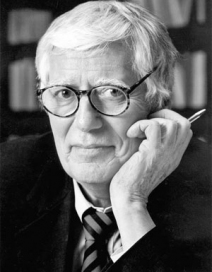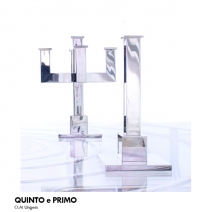Oswald Mathias Ungers

Oswald Mathias Ungers, noto anche con l'acronimo O.M.U., nato a Kaisersesch, Germania nel 1926, è stato un architetto tedesco e teorico dell'architettura, conosciuto per il suo stile caratterizzato dal rigore geometrico ed è considerato il Maestro del Neorazionalismo tedesco. Tra i suoi progetti spiccano i musei di Francoforte sul Meno, Amburgo e Colonia.
Nel 1950, dopo essersi laureato, aprì il suo studio di architettura a Colonia, inaugurando un primo periodo di incarichi che interessarono l’edilizia residenziale e scolastica. A partire dal 1964 Ungers diede maggiore spazio a molti progetti di concorso ed a una profonda ricerca teorica che portò alla definizione della poetica caratterizzante l’opera dell’architetto.Fu uomo di molteplici interessi per la teoria e la storia dell'architettura, e per la morfologia e la trasformazione urbana. Dopo essersi trasferito con la famiglia negli Stati Uniti in seguito alle contestazioni studentesche del Sessantotto in Europa, ha insegnato alla Cornell University e ricoperto il ruolo di chairman del dipartimento di Architettura. Ungers ha proposto un tipo di insegnamento centrato sulla pianificazione urbanistica basata sulla analisi della forma urbana, anticipando analoghe posizioni teoriche da parte dello stesso Rowe e di Aldo Rossi, Robert Venturi, Fred Koetter. Uno dei suoi allievi di questo periodo fu Rem Koolhaas, fortemente debitore del metodo di analisi morfologico-urbano di Ungers per i suoi primi progetti.
Diventato membro dell'AIA (Istituto Americano degli Architetti) nel 1971, Ungers continuò la sua attività di docente, insegnando anche ad Harvard e a Los Angeles fino al 1976, anno in cui tornerà in Germania aprendo un nuovo studio a Francoforte sul Meno. Nel periodo successivo, il lavoro di Unger acquistò maggior importanza internazionale, acquisendo una certa notorietà. Tutta la sua attività “pratica” è stata supportata da scritti teorici per le maggiori testate di architettura secondo una volontà di dare fondamento teorico ai propri progetti sebbene sia stato costretto scendere a compromessi in fase di realizzazione dei progetti stessi. In seguito ad un peggioramento della salute Ungers morì nel 2007 nella sua casa a Colonia all’età di 81 anni.
Oswald Mathias Ungers, also known with the acronym O.M.U., born in Kaisersesch, Germany in 1926, he was a German architect and architectural theorist, known for his style characterized by geometric rigor and is considered the father of German Neorazionalism. Among his projects the most famous are the museums in Frankfurt, Hamburg and Cologne. In 1950, after graduating, he opened his own architectural studio in Cologne, opening a period of tasks oriented to the housing and education. Since 1964, Ungers gave greater prominence to many competition projects and to a deep theoretical research that led him to the definition of poetry in the work of the architect. He was interested in the theory and history of architecture, and morphology and urban transformation. After moving with his family to the United States (due to the student protests in ‘68 in Europe), he taught at Cornell University and served as chairman in the Department of Architecture. Ungers has proposed a kind of teaching focused on planning based on analysis of urban form, anticipating similar theoretical positions by the Rowe, Aldo Rossi, Robert Venturi and Fred Koetter. One of his students of this period was Rem Koolhaas, strongly debtor for his first projects to Unger’s method of morphological-urban analysis. He became a member of the AIA (American Institute of Architects) in 1971, Ungers continued his work as a professor, teaching at Harvard University and Los Angeles University until 1976, when he returned in Germany and opened a new studio in Frankfurt am Main. In this period, the work of Unger gained greater international importance, increasing his notoriety. All of his "practice" has been supported by theoretical writings for the most important journals of architecture in accordance with a desire to provide theoretical basis to his projects even though it was forced to make compromises in the implementation phase of the projects themselves. Following a deterioration in health Ungers died in 2007 at his home in Cologne at the age of 81 years.
Oswald Mathias Ungers, noto anche con l'acronimo O.M.U., nato a Kaisersesch, Germania nel 1926, è stato un architetto tedesco e teorico dell'architettura, conosciuto per il suo stile caratterizzato dal rigore geometrico ed è considerato il Maestro del Neorazionalismo tedesco. Tra i suoi progetti spiccano i musei di Francoforte sul Meno, Amburgo e Colonia.
Nel 1950, dopo essersi laureato, aprì il suo studio di architettura a Colonia, inaugurando un primo periodo di incarichi che interessarono l’edilizia residenziale e scolastica. A partire dal 1964 Ungers diede maggiore spazio a molti progetti di concorso ed a una profonda ricerca teorica che portò alla definizione della poetica caratterizzante l’opera dell’architetto.Fu uomo di molteplici interessi per la teoria e la storia dell'architettura, e per la morfologia e la trasformazione urbana. Dopo essersi trasferito con la famiglia negli Stati Uniti in seguito alle contestazioni studentesche del Sessantotto in Europa, ha insegnato alla Cornell University e ricoperto il ruolo di chairman del dipartimento di Architettura. Ungers ha proposto un tipo di insegnamento centrato sulla pianificazione urbanistica basata sulla analisi della forma urbana, anticipando analoghe posizioni teoriche da parte dello stesso Rowe e di Aldo Rossi, Robert Venturi, Fred Koetter. Uno dei suoi allievi di questo periodo fu Rem Koolhaas, fortemente debitore del metodo di analisi morfologico-urbano di Ungers per i suoi primi progetti.
Diventato membro dell'AIA (Istituto Americano degli Architetti) nel 1971, Ungers continuò la sua attività di docente, insegnando anche ad Harvard e a Los Angeles fino al 1976, anno in cui tornerà in Germania aprendo un nuovo studio a Francoforte sul Meno. Nel periodo successivo, il lavoro di Unger acquistò maggior importanza internazionale, acquisendo una certa notorietà. Tutta la sua attività “pratica” è stata supportata da scritti teorici per le maggiori testate di architettura secondo una volontà di dare fondamento teorico ai propri progetti sebbene sia stato costretto scendere a compromessi in fase di realizzazione dei progetti stessi. In seguito ad un peggioramento della salute Ungers morì nel 2007 nella sua casa a Colonia all’età di 81 anni.
Oswald Mathias Ungers, also known with the acronym O.M.U., born in Kaisersesch, Germany in 1926, he was a German architect and architectural theorist, known for his style characterized by geometric rigor and is considered the father of German Neorazionalism. Among his projects the most famous are the museums in Frankfurt, Hamburg and Cologne. In 1950, after graduating, he opened his own architectural studio in Cologne, opening a period of tasks oriented to the housing and education. Since 1964, Ungers gave greater prominence to many competition projects and to a deep theoretical research that led him to the definition of poetry in the work of the architect. He was interested in the theory and history of architecture, and morphology and urban transformation. After moving with his family to the United States (due to the student protests in ‘68 in Europe), he taught at Cornell University and served as chairman in the Department of Architecture. Ungers has proposed a kind of teaching focused on planning based on analysis of urban form, anticipating similar theoretical positions by the Rowe, Aldo Rossi, Robert Venturi and Fred Koetter. One of his students of this period was Rem Koolhaas, strongly debtor for his first projects to Unger’s method of morphological-urban analysis. He became a member of the AIA (American Institute of Architects) in 1971, Ungers continued his work as a professor, teaching at Harvard University and Los Angeles University until 1976, when he returned in Germany and opened a new studio in Frankfurt am Main. In this period, the work of Unger gained greater international importance, increasing his notoriety. All of his "practice" has been supported by theoretical writings for the most important journals of architecture in accordance with a desire to provide theoretical basis to his projects even though it was forced to make compromises in the implementation phase of the projects themselves. Following a deterioration in health Ungers died in 2007 at his home in Cologne at the age of 81 years.

_600x600.jpg)
_600x600.jpg)
_600x600.jpg)
_600x600.jpg)
